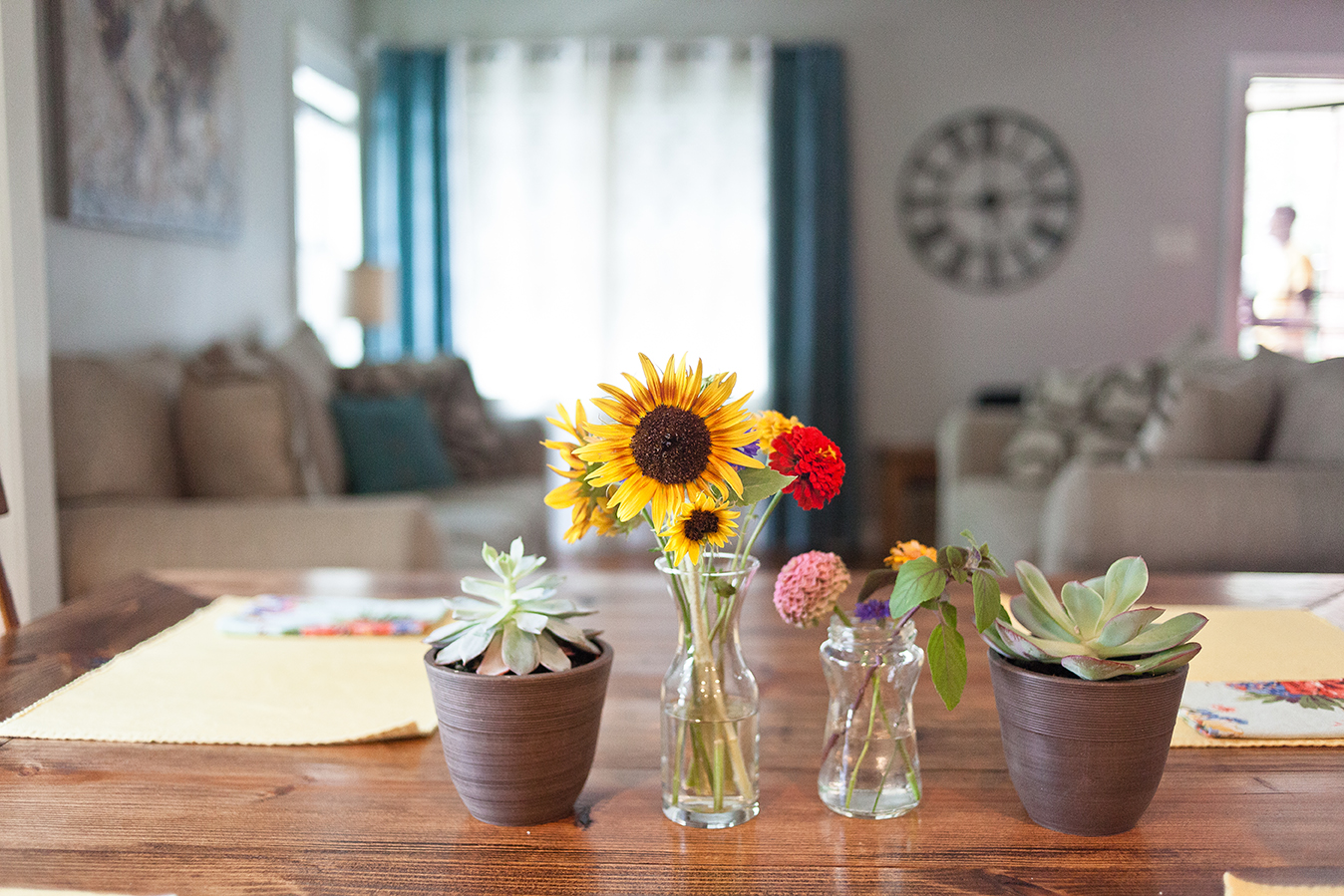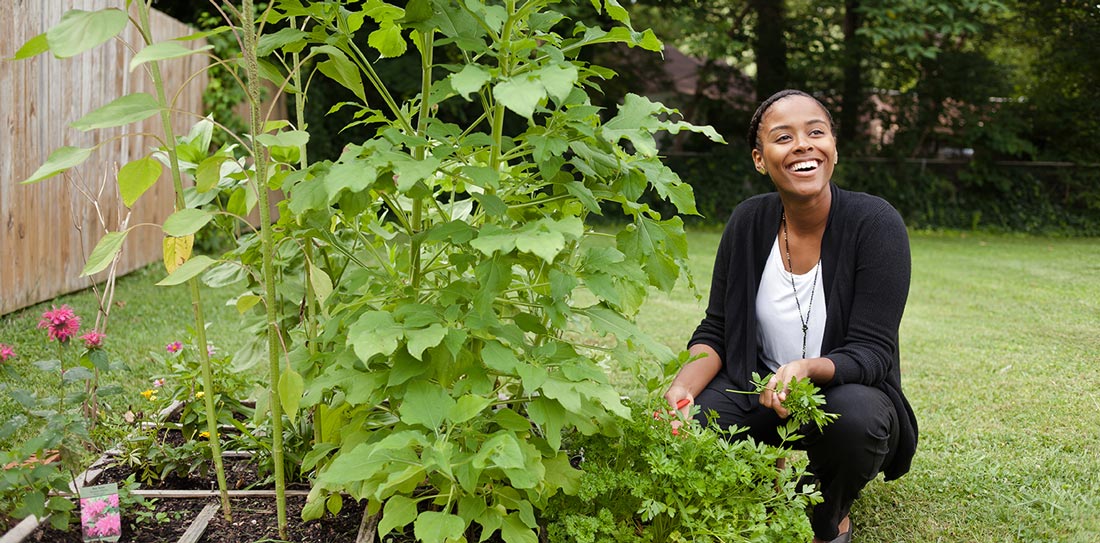Home-cooked meals and an empty trash can

If one stays in a certain corner of the Internet and social media, one could believe that the minimalist and zero waste movements are populated exclusively by women with swishy blond hair and cauliflower obsessions.
Candace Obadina—a consultant, amateur gardener, proud Binghampton resident, thrifty shopper and someone who would choose a carrot over cauliflower any day—blows that stereotype right open. For the last few years, Candace has worked to fine-tune an approach to food that nourishes herself and her family without filling up her garbage can.
Candace minimizes her kitchen waste through a variety of routines: careful menu planning and grocery lists, using The Compost Fairy’s free drop-off sites, reusing containers and pursuing a plant-centric diet. But she didn’t grow up with those habits.
“I come from a family who buys bottled water, uses paper towels like they’re free and never owned a dish towel—like, ever. For most of my childhood I ate TV dinners and prepackaged snacks. A home-cooked meal was a luxury,” remembers Candace.

Her journey toward a healthier, more efficient kitchen has occurred over time, piece by piece. Last year Candace added a small garden in her backyard. This year composting is a new element.
“When I feel like we’ve conquered each new step, I think, ‘What can we add on?’” she explains.
Candace’s food philosophy is influenced by Michael Pollan, a writer who encourages people to think more comprehensively about their food: its origins, its health impact and its wider implications for society and the earth. His mantra—“Eat food, not too much, mostly plants”—is printed at the top of Candace’s weekly grocery lists.

Simplicity and thriftiness anchor her shopping; she purchases only the food that her family will need for the week, balancing quality of items with economic bargains.
Her daughter’s numerous allergies pushed Candace toward intentional meal planning and shopping for items with minimal ingredient lists. Simple foods tend to be cheaper, healthier and less likely to produce an allergic reaction. Win, win, win.
Candace starts with the farmers market on Saturday mornings. First, she drops her compost and then cruises the market for fresh and frugal items like cucumbers and peaches. Next, she goes to Sprouts for items on her list that can’t be found at the market. Finally, Candace visits Whole Foods for the rest of her list, which includes animal products such as cheese, eggs and meat. Detailed menu planning streamlines her shopping experience and provides fulfillment as she nurtures her family with high-quality food.

A fun component of the food-gathering routine is the regular trip to community gardens for free produce. “We stop by each week to see what’s growing. Most people don’t know you can go to any of the community or school gardens and grab what’s growing for free. Last year there was basil growing all over the place at East High. I texted a bunch of my friends and encouraged them to get some to make pesto. I did it again when there was so much kale unused,” says Candace.
Though her family of origin rarely cooked, a close family friend exposed Candace to gardening, canning and home cooking. Her husband’s Nigerian family has shared traditional recipes such as pepe—a combination of bell pepper, habanero, tomato and onion—which forms the base for multiple dishes like jollof rice. Favorite dishes at the Obadina house include fried rice made with bacon, eggs, onions, bell peppers and leftover rice and served alongside grapes. They also love curries and Nigerian beans, or muffins and eggs with fresh fruit and veg. Cookbooks from the library and bloggers provide additional inspiration.

“A raw food challenge changed how I approached preparing my daughter’s lunches.”
“She went from pretzels and packaged granola bars to mostly raw produce. My hope for her is that, as she grows, she will only know how to eat a plant-centric diet and live in a way that produces minimal waste,” says Candace.

While Candace greens her home kitchen, Ashley Cabrera works to reduce waste in kitchens and grocery stores across Tennessee. As the creative services coordinator for the Tennessee Department of Environment and Conservation (and as an unofficial green bean enthusiast), Ashley gathers research, runs education campaigns and works with community partners like Kroger to prevent and redirect food waste. She’s straightforward about the severity of food waste in the United States.
“Imagine that you purchase eight bags of food at the grocery store. While in the parking lot, you dump three bags and never bring them home. That’s the average amount of food wasted, which costs an average family $130 to $230 per month on groceries that are never used,” says Ashley.

Ashley’s data show that 75 to 80 percent of food waste comes from home kitchens and grocery stores.
The good news is that individual choices can really move the needle on the $165 billion wasted annually in the United States on food and the additional $750 million spent to transport that unused food to the landfill.
Waste is broader than consumer spending and strain on landfills. Food that goes uneaten still requires energy to produce. (Think: the grass that fed the cows, the labor to milk them, homogenization and pasteurization processes, containers, transportation, labeling, stocking, pricing, scanning.) Waste stretches both backward and forward from what we see in a trash can.
To Ashley, food is more than a commodity. Food is an investment of resources, time, labor, money and even pollution.
“When we treat ample food as a gift—a gift that not everyone shares, frankly—we are less likely to toss it aside without a second thought,” she says. We might even remember to be grateful.

Ashley’s starting points for streamlining the home kitchen sound a lot like what Candace has already put into practice:
Buy less. Eat what you need. Plan well.
It’s not complicated, but it does require attention. Partway into her journey, Candace realized that her family had given her some tools that she needed to live simply.
“I read an article about how people of color and poor people have for generations been making choices to green their kitchen. I thought it was funny when a different, European American blogger suggested reusing old food containers as a way to green the kitchen. I thought to myself, ‘Isn’t that obvious? Everyone I knew growing up did that,’” says Candace.
Kitchens reflect values.
Candace makes small changes to care for her family, her budget, her patch of earth, her health. She measures her impact in terms of personal habits. Ashley cares about the state of Tennessee’s rivers, forests and cities as well as her own young family. She’s measuring tons of food that avoid landfills. Ashley and Candace point toward a healthier future for all.

Ten Things You Can Do Today to Green Your Kitchen:
Tips from Candace, Ashley and Heidi
-
Compost. If you don’t want to tend your own bin, call The Compost Fairy.
-
Eat slowly. Appreciating the colors, textures and tastes of your food will keep you from dumping some of it in the trash.
-
Purchase produce without packaging. Bring along your own lightweight bags if you like.
-
Eat leaves and stems. Beet and carrot greens, to take just two examples, are delicious and jam-packed with nutrients your body loves. Try sautéing the beet greens or making pesto from the carrot tops.
-
Replace single-use items such as paper napkins and plastic wrap with reusable alternatives like cloth napkins and beeswax wraps.
-
Plan menus. A plan keeps impulse purchases to a minimum (and reduces extra trips to the store—bonus!).
-
Eat perishable items first. Ashley recommends designating an “Eat First” section of the refrigerator in order to prioritize food that is time-sensitive.
-
Maintain a short list of “blank canvas recipes” that can accommodate odd amounts or combinations of leftover ingredients, e.g., fried rice, fajitas, frittata, pasta salad, etc. For recipes that target odd amounts and leftovers, check out savethefood.com.
-
Buy fewer groceries and try to eat them all. Congratulate yourself on the money you saved.
-
Know how your food is supposed to taste, regardless of the “sell by” date. If it still smells and tastes good, use it up.
Further Reading (Candace’s Favorites):
Any of Michael Pollan’s writings
goingzerowaste.com/blog/the-5-rs-of-zero-waste
minimalistbaker.com
budgetbytes.com
bluezones.com/recipes/food-guidelines
For more about Ashley’s work, check out getfoodsmarttn.com or savethefood.com.

